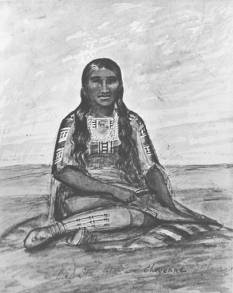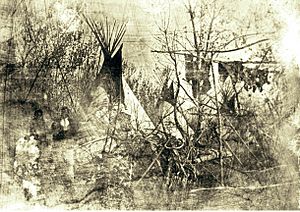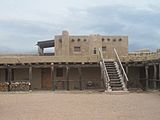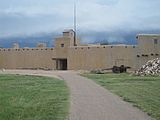Owl Woman facts for kids

Owl Woman (Cheyenne name: Mis-stan-stur; died 1847) was a special Cheyenne woman. She was the daughter of White Thunder, a respected medicine man in the Cheyenne tribe. Owl Woman married an American trader named William Bent. They had four children together. Owl Woman was honored in the Colorado Women's Hall of Fame. This was because she helped manage important relationships between Native American tribes and the American traders.
Life on the Plains
Native American Tribes of the Central Plains
In the 1820s, many Native American tribes lived in the central plains. This area was changing a lot. The Arkansas River was an important border. Mexico was to the south, and the United States was to the north. There were new chances for trade. The United States was also expanding west, a policy called manifest destiny.
Native American tribes like the Comanche, Kiowa, Cheyenne, and Arapaho were also moving. They sought new lands for hunting or a better way of life. The Cheyenne likely moved to the plains in the 17th and 18th centuries from Minnesota. By the mid-1800s, the Cheyenne and Arapaho lived north of the Arkansas River. This was near Bent's Fort in Colorado.
The Comanche moved to the southern plains for a better life. This sometimes caused disagreements with other tribes. In 1840, a special agreement called "The Great Peace of 1840" was made. The Comanche agreed to stay south of the Arkansas River. The Cheyenne and Arapaho agreed to stay north of it.
William Bent and the Santa Fe Trail
William Bent was a white trader from St. Louis. He came to the Arkansas River area in the late 1820s. Around 1832 to 1834, he built a trading post called Bent's Fort. This was a large building made of adobe. It could hold up to 200 people. The fort was built on the "Mountain Route" of the Santa Fe Trail. It was near La Junta, close to the Cheyenne and Arapaho lands.
Bent's Fort became a very important trading center. People mainly traded buffalo robes. They also traded horses, mules, and many other goods. William Bent worked with his brother, Charles, and Ceran St Vrain. The fort was in a perfect spot for trading. For example, brandy bought for $2 in St. Louis could sell for $25 at the fort.
White Thunder, Owl Woman's father, saw a special connection with Bent. In November 1833, they talked during a meteor shower. Many Cheyenne thought the world was ending. White Thunder saw it as a new beginning. He wanted peace with the Pawnees and the return of sacred Cheyenne arrows. He also realized that a marriage between Bent and his daughter would bring peace to the Cheyenne and the region.
Bent already knew the Cheyenne language. The Native tribes called him Little White Man. He and his brothers were given native names when they first met the Cheyenne. They showed respect for Cheyenne customs. This helped them build a strong relationship for the fort and trading.
Life at Bent's Fort
Bent's Fort was a busy place. People from many different backgrounds lived and visited there. This included Native American tribes like the Sioux, Apache, Kiowa, Comanche, and Cheyenne. It was a trading center for 500 miles around. Hundreds of wagons traveling the Santa Fe trail visited each year.
The fort was a safe place for trade. People often sat in the courtyard and smoked together. Bent managed the trade. He provided goods for the store. He also helped send buffalo robes back to St. Louis for sale.
Bent's Fort was a resting stop for travelers. Some stayed for weeks. From fall to spring, the fort was full of traders and travelers. They came to rest and get supplies. Workers at the fort included clerks, guards, traders, and a blacksmith. Caravans also took goods to trade with Native American tribes.
During the summer, the fort was quieter. William Bent often traveled for six months to Westport, Missouri. He traded goods collected in winter and restocked the fort. A small group of workers stayed at the fort during this time.
William and Charles Bent had workers named Andrew, Dick Green, and Charlotte. Charlotte was a cook known for her amazing food. She was called "the only lady in the whole d***n Injun country" by a visitor. Bent's Fort often held dances. Charlotte was always the center of attention. Dick Green was freed after he showed great bravery in a battle in 1847. He helped American soldiers in Taos after Charles Bent died.
Bent's Fort: A Place for Peace
Before Owl Woman married Bent, the Cheyenne and Arapaho wanted to work with the traders. They saw the trade caravans as a chance to get richer. Bent had also protected the Cheyenne from Comanche raiders once. This made the Cheyenne favor him.
Bent worked hard to solve problems between the tribes. He also helped stop raids on settlers and traders. This created a fragile peace. The fort became a place where different groups could talk and trade.
In 1840, Bent's Fort became the site of a major peace agreement. The Comanche, Apache, and Kiowa tribes made a truce with the Cheyenne and Arapaho. This created an important network of peace. The Comanche had protected their land south of the Arkansas River for many years. But with new tribes and white settlers moving in, there were many battles. A Comanche raid on the fort in 1839 and a Cheyenne counter-raid led to a desire for peace.
The tribes agreed to peace. The formal agreement happened at the fort over several weeks in the summer of 1840. Bent played a key role as host. He welcomed the different camps and their celebrations. The Arkansas River was an important border between the Comanche and Cheyenne. Bent's Fort created a safe place where business could happen and lives could be lived peacefully.
Owl Woman's Story
Family and Background
Owl Woman's birth date is not known. She was the oldest daughter of White Thunder and Tail Woman. She had at least two younger sisters, Yellow Woman and Island. Her father, White Thunder, was an important Cheyenne leader. He was the "Keeper of the Arrows," which were sacred to the tribe. His high position as a spiritual leader brought respect to his daughters.
The Cheyenne were a nomadic plains tribe. They followed and hunted buffalo. They were known for being tall and well-built. People described them as "honorable, intelligent, honest and clean."
Marriage to William Bent
It was common for white traders to marry Native American women at this time. These marriages often helped both sides. Bent and Owl Woman's relationship was a true partnership. It led to "children, wealth and power." For Bent, marrying a Cheyenne woman helped his trading business. It strengthened his alliance with the tribe. For White Thunder, it protected his tribe and brought him more respect.
Bent followed Cheyenne customs to court Owl Woman. Even talking to a Cheyenne girl was seen as courtship. So, he had to get permission first. He exchanged ponies with White Thunder. During courtship, Owl Woman's sister, Yellow Woman, always chaperoned them. This followed the Cheyenne custom of staying celibate until marriage.
To ask for Owl Woman's hand, Bent brought horses and gifts to White Thunder's camp. He smoked a peace pipe with Owl Woman's father. Owl Woman wanted to marry Bent. White Thunder made the final decision. He joined William Bent's hands with Owl Woman's. This meant they were married. It also meant Bent would accept Owl Woman's sister, Yellow Woman, as part of the family.
Owl Woman and William Bent married in a Cheyenne ceremony in 1835 or 1837. As part of the custom, Owl Woman was carried into a lodge built for them in the Cheyenne village. Bent gave many gifts. Later, Bent became a "Cheyenne sub-chief" because of his marriage.
Life at the Fort and Village
Owl Woman and Bent spent time at both the fort and the Cheyenne village. Their homes reflected their different backgrounds. Owl Woman did not like staying at the fort much. Her room was dark and near the noisy blacksmith shop. The animals were also loud and smelly. She preferred her quiet lodge in the village. It was lit by the parchment roof.
By the 1840s, Owl Woman's younger sisters, Island and Yellow Woman, joined them. This was a Cheyenne custom for successful men. In 1845, Yellow Woman had a son with William named Charley. His Cheyenne name was Pe-ki-ree, meaning White Hat.
In April, Bent would leave the fort for his six-month journey to Missouri. During the summer, his family moved between the fort and the Cheyenne village. They would be back at the fort by autumn.
Winter at Big Timbers

The Cheyenne tribe moved seasonally to Big Timbers. This was about 30 miles down the Arkansas River. Big Timbers was a great place to hunt buffalo. Buffalo were a main food source for the Cheyenne. The tribe also ate roots and berries. Big Timbers was their favorite winter camp.
Owl Woman and her children traveled with her tribe to Big Timbers in winter. They stayed at the fort in summer. When the Cheyenne were at Big Timbers, Bent joined his family. He brought goods for trading. At Big Timbers, Bent lived more like the Cheyenne. Life at Bent's Fort was more structured, with William in a leadership role.
Life in the village meant constant movement. Sometimes they went to Big Timbers for buffalo. Sometimes they went to the fort. They always chose places with good grass, wood, and fresh water.
Owl Woman's Important Role
Soon after their marriage, Owl Woman and Bent became very important leaders in the region. They combined their family and trading connections. They worked with tribes, traders, and authorities from New Mexico and the US Army. They were both active peacemakers. They helped explorers, settlers, and members of many Native American tribes who visited the fort.
Owl Woman worked at the fort. She often managed the supply trains. Her position helped protect the trade caravans. It is said she could signal with a mirror to warn off tribes who might try to raid the caravans.
In 1845, a military engineer named Lieutenant James W. Abert drew Owl Woman. He wrote that she was "a remarkably handsome woman." He noted her "small, delicately formed" hands and "wavy hair." She wore her best dress for the drawing. Her dress and leggings were decorated with beads. She sat in a modest way, which he found typical of her.
Their Children
Owl Woman and William Bent had four children together. Their children had both English and Cheyenne names:
- Mary (Cheyenne name: Ho-ka) was born on January 22, 1838.
- Robert (Cheyenne name: Octavi-wee-his) was born around 1840-1841.
- George (Cheyenne name: Ho-my-ike) was born on July 7, 1843.
- Julia (Cheyenne name: Um-ah) was born in 1847.
Life at the fort, called the "mud castle of the plains," mixed both parents' cultures. The children wore linen shirts and soft-leather moccasins. They ate on fine china but slept on the ground on soft hides, as was Cheyenne custom. Their home had items from America, Mexico, and other countries. The children enjoyed pumpkin pie and pancakes made by Charlotte, a cook at the fort. Chipita, a French-Mexican worker, made taffy for them.
Owl Woman's mother taught the children to respect their elders. They were disciplined with stern looks and waving fingers from their mother and aunts. The children learned many languages. George learned Cheyenne, English, Spanish, Comanche, Kiowa, and Arapaho. The boys learned to ride horses bareback, hunt, and be warriors. The girls learned chores like gathering wood and fetching water. They were also taught to be kind hosts. George Bent remembered his childhood at the fort:
Something was always going on, and we children had no lack of amusements. In the fall and winter there was always a large camp of Indians just outside the fort — Cheyenne and Arapahos, and sometimes Sioux, Kiowas, Comanches, and Prairie Apaches.
Life changed for the Bent family after Owl Woman's death. In 1849, a cholera sickness spread through the Cheyenne tribe. It killed many people, including the children's grandmother, Tail Woman. The demand for fur also dropped, affecting William Bent's business. In 1853, Bent built a new stone fort in the Big Timbers area.
After Owl Woman died, George was sent to school in Westport, Missouri in 1854. He was separated from his family for much of the time.
Death and Legacy
Owl Woman died in 1847 from problems after giving birth to Julia. William Bent was away at the time and deeply mourned her. Her sister Island took care of Bent and Owl Woman's children.
Owl Woman was described as "a most estimable good woman of much influence in the tribe." She worked hard to improve relations between Native American tribes and white people. She and Bent found a way to connect two different worlds. They used Native trading systems and European goods to create a new way of life for their children.
Their vision for peace did not last forever, as bigger events changed the region. But Owl Woman's contributions were remembered. She was inducted into the Colorado Women's Hall of Fame in 1985.





